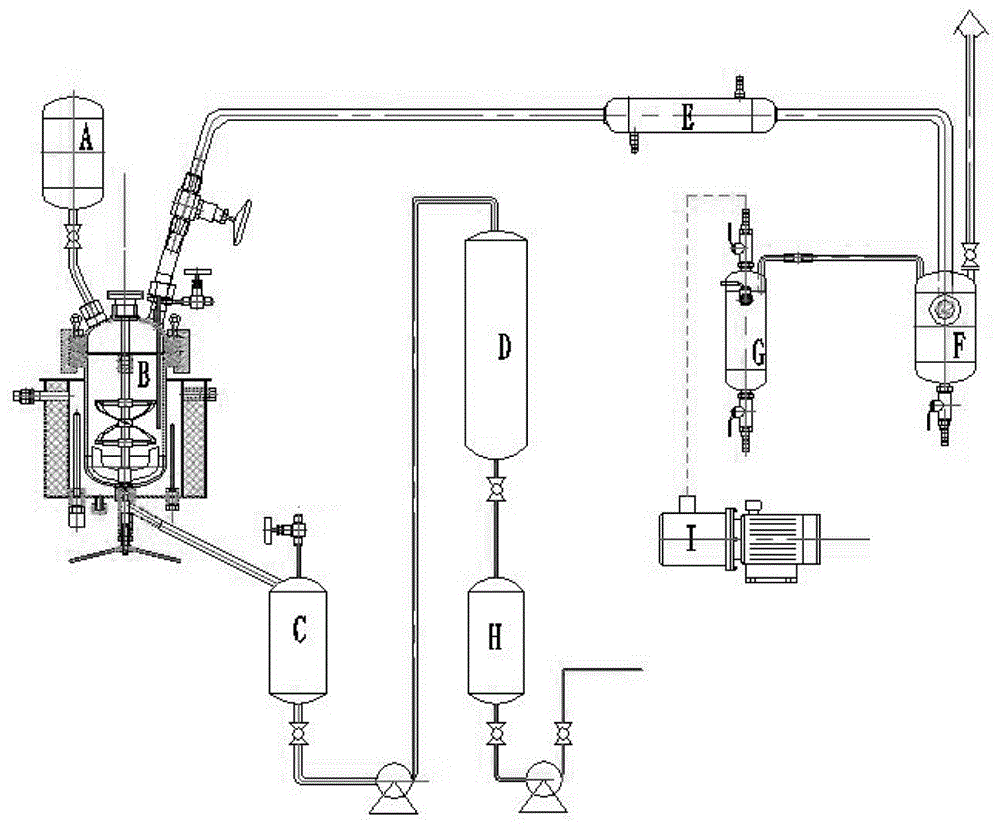Method for producing trifluoro-propyl silicone oil by aid of ion exchange resin
A technology of ion exchange resin and trifluoropropyl silicon, which is applied in the field of producing trifluoropropyl silicone oil with ion exchange resin, can solve the problems of lagging development, difficulty in the synthesis technology of organic fluorine monomers, monopoly, etc., and achieve low production cost , low polymerization reaction temperature, cheap effect
- Summary
- Abstract
- Description
- Claims
- Application Information
AI Technical Summary
Problems solved by technology
Method used
Image
Examples
Embodiment 1
[0022] Take 300g of the by-product of ring distillation and 220g of D3F raw material after pretreatment to a 1000ml three-necked flask (the main components of the by-product of ring distillation are: 22.5% linear siloxane, 64.5% cyclic siloxane, 4.4% Low-boiling organic components, 0.1% trace elements and mechanical impurities.), stir and heat up to 80 ± 5 ℃, dehydration under the conditions of a vacuum of 0.09 MPa for 1 hour, and add a blocking agent (MM quality and water pretreatment after removing the vacuum) After the treatment, the percentage of the sum of the mass of the by-product of the ring distillation and the mass of the raw material D3F, in this example, MM adds 4.5g), heats to 75±5℃, and then adds the catalyst (NHD-6) to the three-necked flask. The addition amount is 5% of the sum of the mass of the by-products of the ring distillation after water pretreatment and the mass of the raw material D3F), react for 1 to 3 hours under normal pressure, stirring speed 200~230...
Embodiment 2
[0024] Take 300g of the by-product of ring distillation and 220g of D3F raw material after pretreatment to a 1000ml three-necked flask (the main components of the by-product of ring distillation are: 20% linear siloxane, 66% cyclic siloxane, 4.3% Low-boiling organic components, 0.05% trace elements and mechanical impurities.), stir and heat up to 80 ± 5 ℃, dehydration under the conditions of a vacuum of 0.09 MPa for 1 h, and add a capping agent (MM quality and water pretreatment after removing the vacuum) After the treatment, the percentage of the sum of the mass of the by-product of the ring body distillation and the mass of the raw material D3F. In this example, MM was added 4.0g), heated to 75±5℃, and then added the catalyst (NHD-6) to the three-necked flask. The addition amount is 5% of the sum of the mass of the by-products of the ring distillation after water pretreatment and the mass of the raw material D3F), react for 1 to 3 hours under normal pressure, stirring speed 20...
Embodiment 3
[0026] Take 300g of the by-product of ring distillation and 220g of D3F raw material after pretreatment to a 1000ml three-necked flask (the main components of the by-product of ring distillation are: 12.5% linear siloxane, 60.9% cyclic siloxane, 3.5% Low-boiling organic components, 0.05% trace elements and mechanical impurities.), stir and heat up to 80 ± 5 ℃, dehydration under the conditions of a vacuum of 0.09 MPa for 1 h, and add a capping agent (MM quality and water pretreatment after removing the vacuum) After the treatment, the percentage of the sum of the mass of the by-product of the ring distillation and the mass of the raw material D3F, in this example, MM adds 4.5g), heats to 75±5℃, and then adds the catalyst (NHD-6) to the three-necked flask. The addition amount is 10% of the sum of the mass of the by-product of ring distillation after water pretreatment and the mass of the raw material D3F), react for 1~3h under normal pressure, stirring speed 200~230r / min, and ho...
PUM
| Property | Measurement | Unit |
|---|---|---|
| boiling point | aaaaa | aaaaa |
| density | aaaaa | aaaaa |
| density | aaaaa | aaaaa |
Abstract
Description
Claims
Application Information
 Login to View More
Login to View More - R&D
- Intellectual Property
- Life Sciences
- Materials
- Tech Scout
- Unparalleled Data Quality
- Higher Quality Content
- 60% Fewer Hallucinations
Browse by: Latest US Patents, China's latest patents, Technical Efficacy Thesaurus, Application Domain, Technology Topic, Popular Technical Reports.
© 2025 PatSnap. All rights reserved.Legal|Privacy policy|Modern Slavery Act Transparency Statement|Sitemap|About US| Contact US: help@patsnap.com

